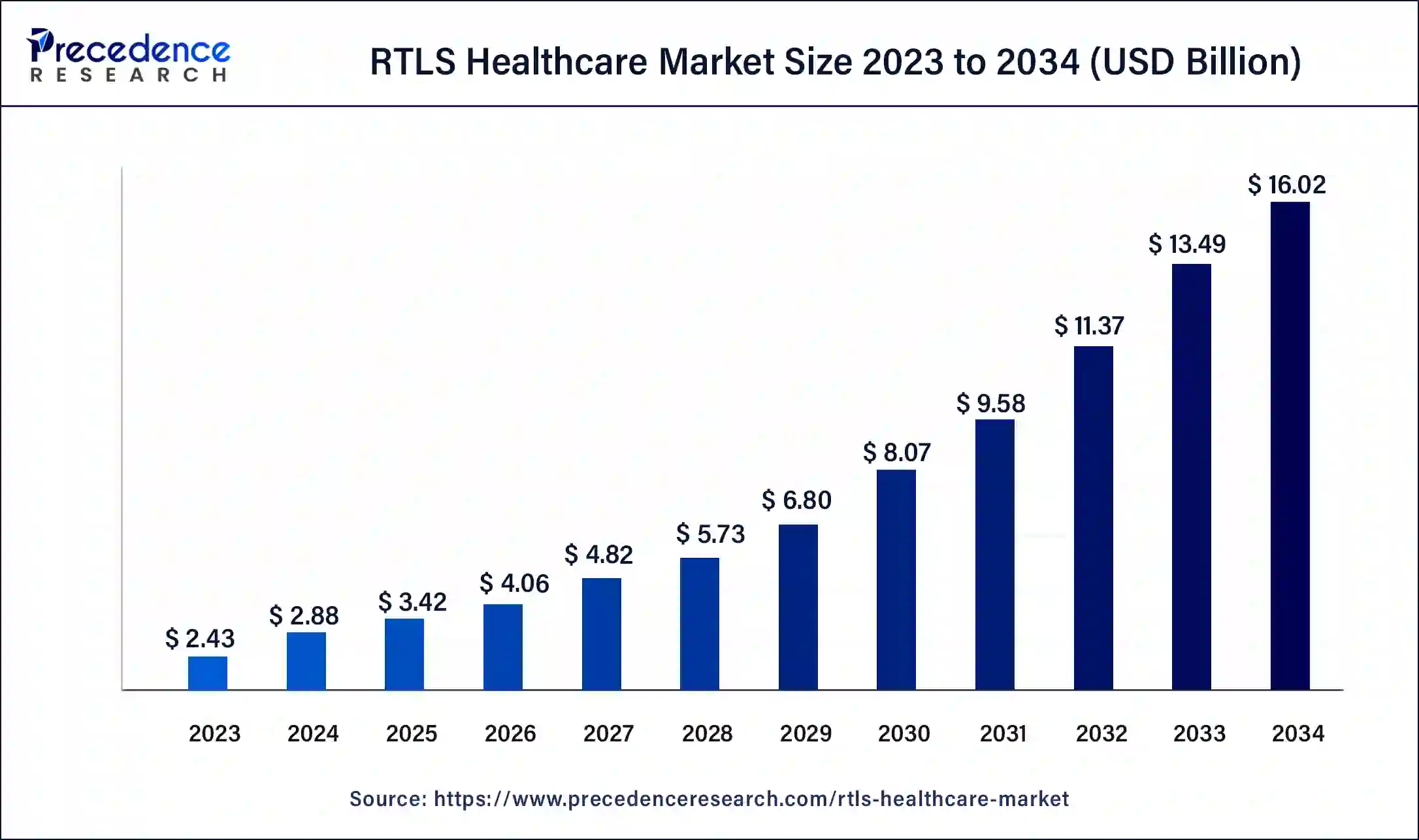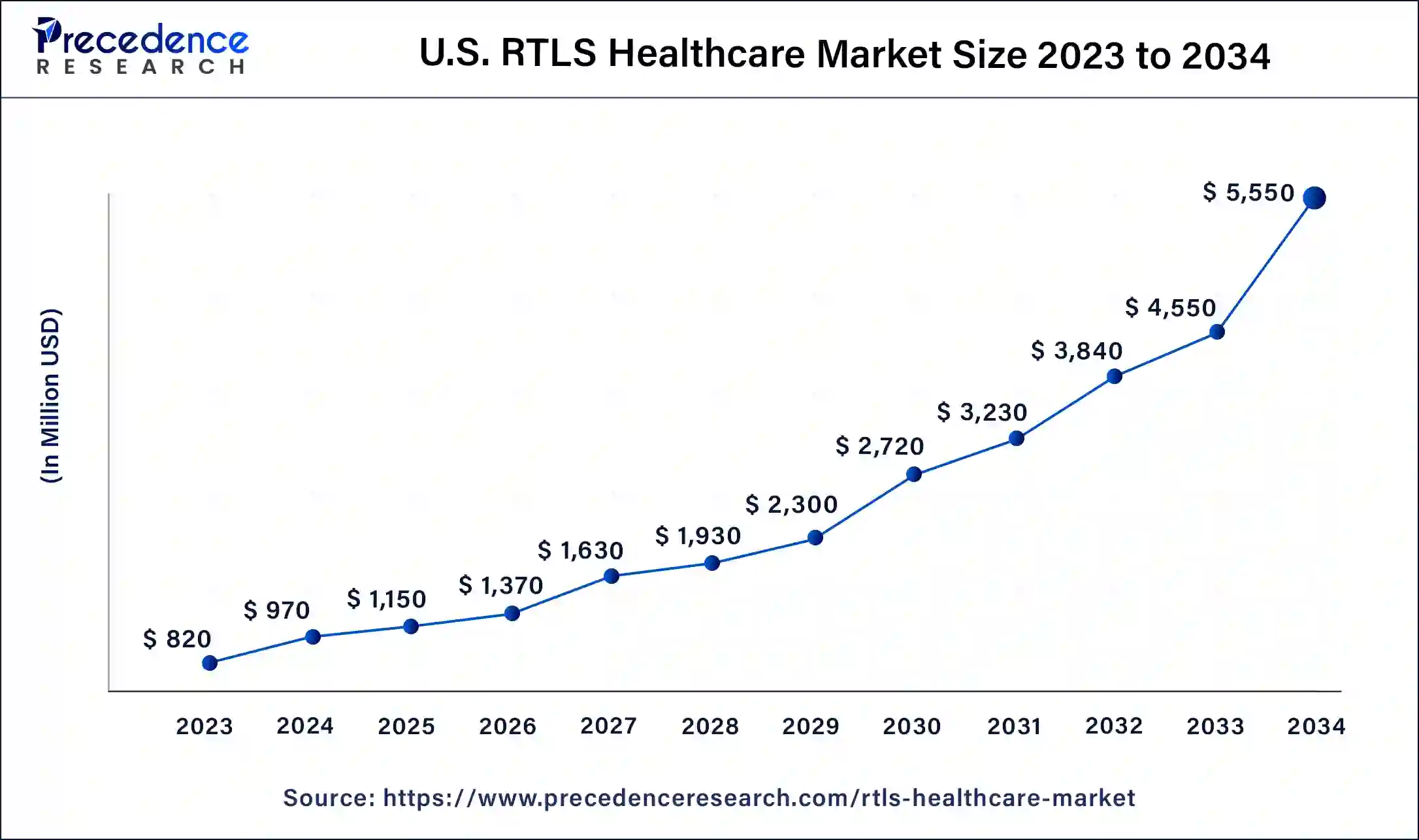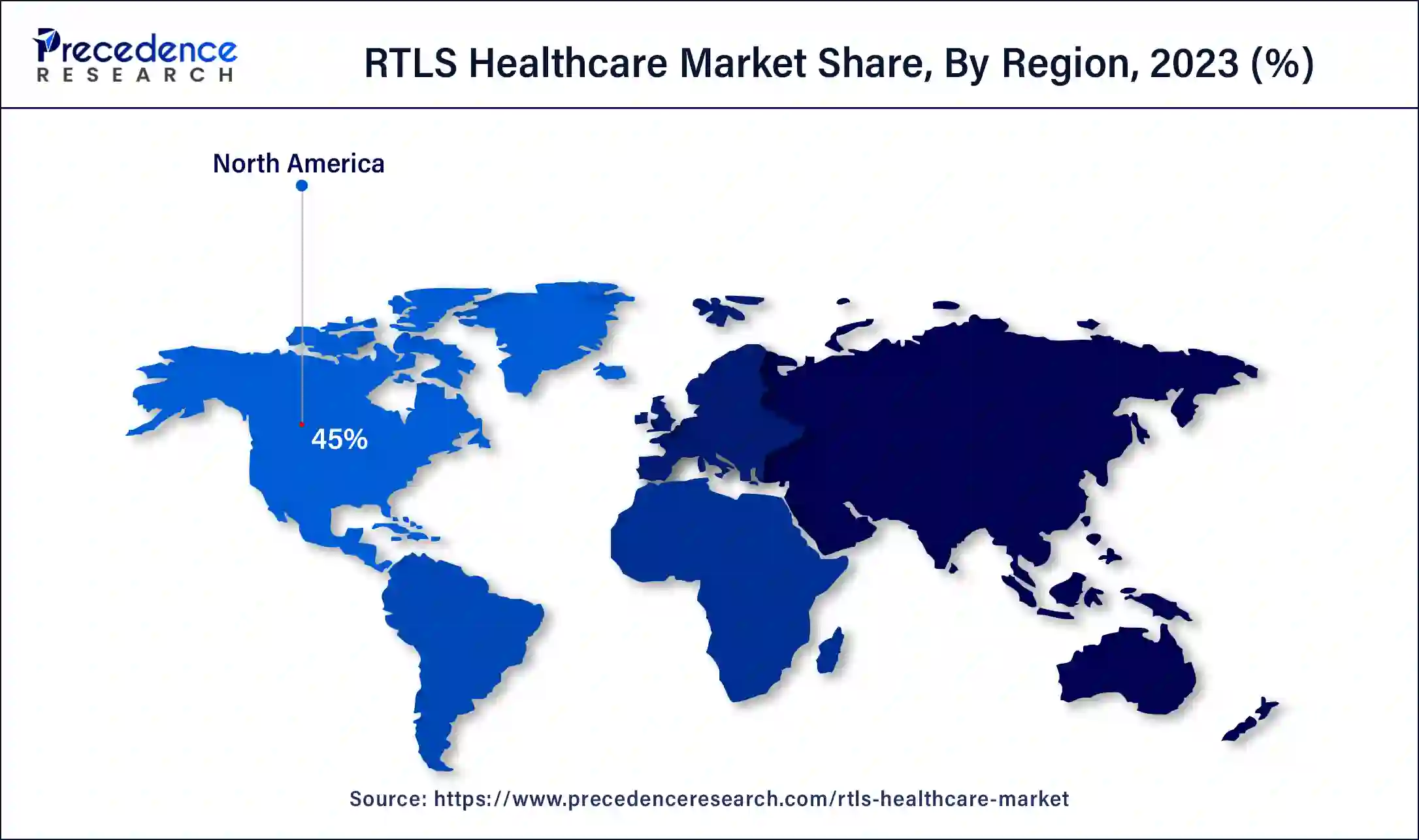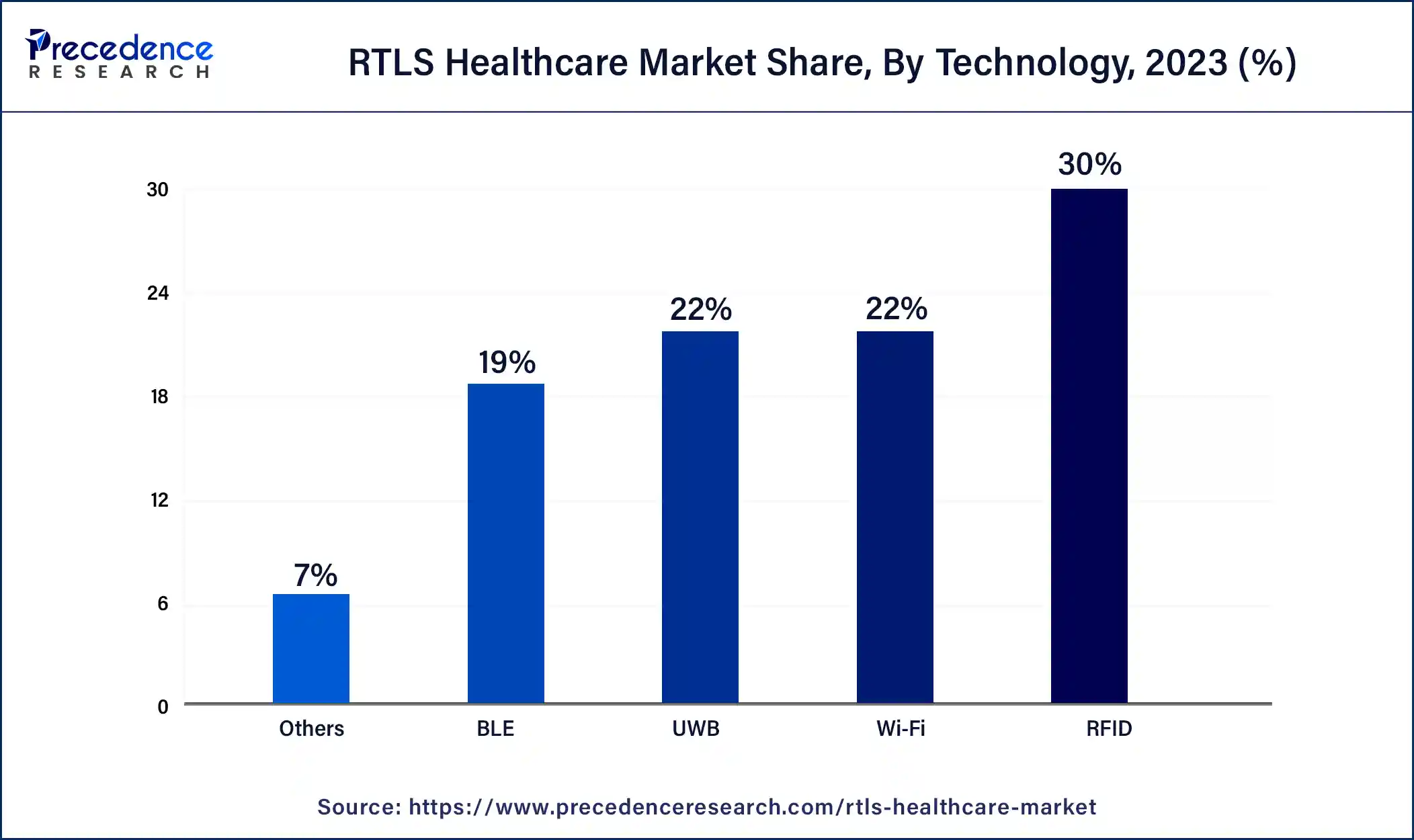January 2025
The global RTLS healthcare market size surpassed USD 2.43 billion in 2023 and is estimated to increase from USD 2.88 billion in 2024 to approximately USD 16.02 billion by 2034. It is projected to grow at a CAGR of 18.70% from 2024 to 2034.
The global RTLS healthcare market size is projected to be worth around USD 16.02 billion by 2034 from USD 2.88 billion in 2024, at a CAGR of 18.70% from 2024 to 2034. The benefits of RTLS healthcare include increased healthcare quality, reduced expenses by preventive maintenance, improved patient experience, etc. contributing to the growth of the market.

U.S. RTLS Healthcare Market Size and Growth 2024 to 2034
The U.S. RTLS healthcare market size was exhibited at USD 820 million in 2023 and is projected to be worth around USD 5,550 million by 2034, poised to grow at a CAGR of 18.88% from 2024 to 2034.

North America dominated the RTLS healthcare market in 2023. The adoption of RTLS technology in the healthcare industry resulted in significant movement, which helped the growth of the market. Increased demand for the use of RTLS solutions, highlighting the region's commitment to improvement and its struggle to improve patient outcomes and healthcare efficiency across the region. Advancements in RTLS healthcare technology contribute to the growth of the market.

Asia Pacific is estimated to be the fastest-growing during the forecast period of 2024-2033. Growing demand for effective supply chain management in healthcare or hospitals and the increasing many hospitals in the Asia Pacific region contribute to the growth of the RTLS healthcare market. Expanding healthcare infrastructure and the presence of a remarkable pharmaceutical sector contribute to the growth of the market.
The RTLS healthcare market refers to real-time location systems (RTLS) services in healthcare designed to provide real-time tracking and management of staff, patients, and assets within a healthcare facility. RTLS hospitals are systems that identify and track the locations of individuals or assets inside the premises. Increased healthcare quality because of accurate asset tracking, reduced costs by preventive maintenance and analytics, well-organized workflow for better operational efficiencies, and enhanced patient experience by effective equipment and workflow use.
RTLS Healthcare Market Growth Factors
How is AI Changing RTLS Healthcare?
The use of AI in RTLS healthcare helps the growth of the RTLS healthcare market. By improving healthcare operations, AI-based RTLS increases outcomes for both overburdened patients and staff. The benefits of AI-based RTLS healthcare include spending less effort on manual or hand-operated tracking and unnecessary tasks with AI automation. Hospitals obtain smarter staff use that focuses on direct patient care activities.
| Report Coverage | Details |
| Market Size by 2034 | USD 16.02 Billion |
| Market Size in 2023 | USD 2.43 Billion |
| Market Size in 2024 | USD 2.88 Billion |
| Market Growth Rate from 2024 to 2034 | CAGR of 18.7% |
| Largest Market | North America |
| Base Year | 2023 |
| Forecast Period | 2024 to 2034 |
| Segments Covered | Component, Technology, Application, Facility Type, and Regions |
| Regions Covered | North America, Europe, Asia-Pacific, Latin America, and Middle East & Africa |
Increasing safety and security concerns of patients
The increasing safety and security concerns of patients contribute to the growth of the RTLS healthcare market. RTLS healthcare system helps to reduce staffing shortage, eliminates costs with analytics and well-organized workflow, enhances the patient experience, and supports staff and patient safety in hospitals. Patient risks include physical attacks, hospital-acquired infections, and equipment errors. The RTLS may promote safety by eliminating room for these risks.
Restraint
Downsides of RTLS healthcare
The downsides of RTLS healthcare include criticality in maintenance and implementation, high installation and maintenance costs that depend on installation area and customer requirements, lack of awareness and expertise related to RTLS solutions, etc. can hamper the growth of the RTLS healthcare market. The high costs of the RTLS system are due to the high cost of software, hardware, power, wiring, and infrastructure.
Opportunity
Future scope of RTLS healthcare
The future scope of RTLS healthcare includes healthcare facilities looking for solutions to shape the effectiveness of the services while cutting expenses, which will help the growth of the RTLS healthcare market. Healthcare providers are also looking for tools that can help optimize their existing resources. 96% of healthcare providers are planning to expand the use of the RTLS system to monitor patients effectively throughout the treatment.
The hardware segment dominated the RTLS healthcare market in 2023. Hardware components like communication infrastructure, sensors, and RFID tags are necessary for RTLS functionality. They allow real-time tracking and data collection of patients, personnel, and assets. These factors help to the growth of the market. Certain technical standards and applications are different; all the RTLS platforms’ basic components are software and hardware components, including the management portal, receivers, transmitters, etc.
The service segment is expected to be the fastest-growing during the forecast period. The service of RTLS healthcare has the necessary components, including integration, deployment, maintenance, support, and consulting. The services play an important role in RTLS healthcare in improving customer experience, ensuring seamless technology adoption, and improving operational efficiency.
The RFID segment dominated the RTLS healthcare market in 2023 and is anticipated to be the fastest-growing during the forecast period. The benefits of RFID technology include increased revenues, health & safety improvements, improved transparency and visibility, improved data accuracy, automation, better inventory management, real-time data, improved asset tracking, accelerated supply chain processes, and improved operational efficiency that helps the market’s growth.

The UWB segment is anticipated to grow significantly during the forecast period. The benefits of UWB (Ultra-wideband) technology include it playing an important role in wireless communication in RTLS healthcare. It is a real-time location system for pairing 2 or more devices or locating devices. It is used in RTLS healthcare communication technologies for automatic target recognition. In security systems, digital contactless keys are used to help with augmented reality, IoT implementation, wireless data transfer, etc., contributing to the growth of the RTLS healthcare market.
The inventory/asset tracking & management segment dominated the RTLS healthcare market in 2023. The benefits of inventory/asset tracking & management include assurance that perishable goods remain under optimal conditions, safe movement of dangerous machinery, loss & theft prevention, improved productivity, improved visibility, expedited accounting processes, maintaining accurate records, keeping track of key documentation, speeding up inventory counts and audits, extending the life of assets, eliminating maintenance costs, etc. contribute to the growth of the market.
The personnel locating & monitoring segment is estimated to grow significantly during the forecast period. The personnel locating & monitoring solution is a technology that offers the safety of employees during work time, an easy way to monitor location. When there is an emergency, employees may alert emergency services or their employer, who will respond instantly, preventing escalation and eliminating the level of harm to the lone worker.
The hospitals & healthcare facilities segment dominated the RTLS healthcare market in 2023. The benefits of hospitals & healthcare facilities include an enhanced visitor experience are all aims which may be obtained by healthier buildings, a more effective and productive workforce, the ability to retain and attract staff, less risk of hospital-acquired infections, and better recovery of patients, which helps to the growth of the market.
The senior living facilities segment is anticipated to grow significantly during the forecast period. The benefits of senior living include a range of amenities, a more active lifestyle without the effort, restaurant style and healthy dining, increased security, safety features, maintenance-free living, scheduled outings, intellectual stimulation, activities and social events, 24-hour care, and personalized care plans.
Segments Covered in the Report
By Component
By Technology
By Application
By Facility Type
By Geography
For inquiries regarding discounts, bulk purchases, or customization requests, please contact us at sales@precedenceresearch.com
No cookie-cutter, only authentic analysis – take the 1st step to become a Precedence Research client
January 2025
December 2024
February 2025
April 2024